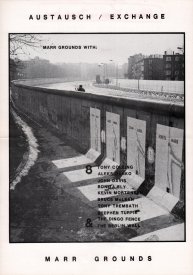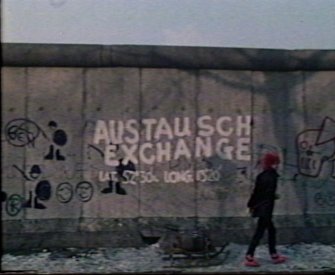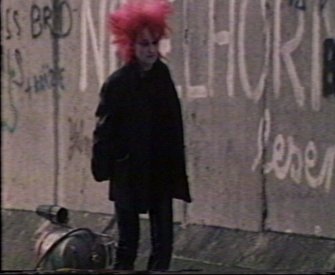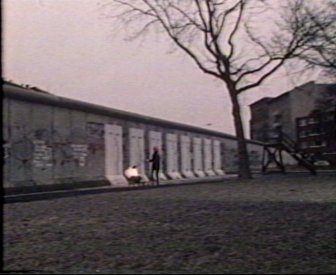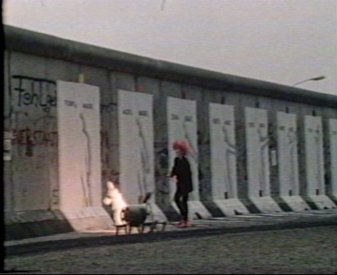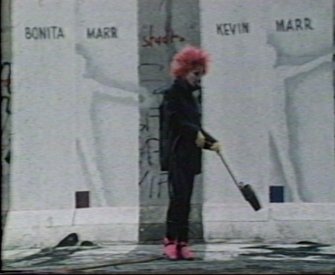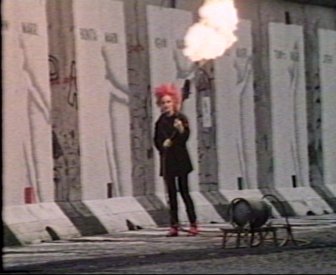16mm film and 3/4” U-matic cassette video: 9 mins, col, sd. Artist: Marr Grounds. Director: Egon Bunne (aka Llurex). Co-Director: Marr Grounds. Producers: Marr Grounds and Llurex. Actress: Jacqueline Schoone. 16mm film and 3/4” U-matic cassette video: 9 mins, col, sd.
Artist: Marr Grounds
Director: Egon Bunne (aka Llurex)
Co-Director: Marr Grounds
Producers: Marr Grounds and Llurex
Actress: Jacqueline Schoone
Camera: Rick Feist
Sound: Renate Scholle and Marty Tismer
Music: ABM
Dingo Fence Material: Jim Dale
The action aspect of the work was originally shot on 16mm film. This was edited together with footage from the Dingo Fence/Oxide St Junction works and is presented as video. It was produced by Marr Grounds and Egon Bunne (aka Llurex) in Berlin, 1982. It is mainly a record of an installation of eight wall posters by Australian artists on the western side of the Berlin Wall.
The video is a record of an ‘action’ performed by the actor Jacqueline Schoone. She appears at the opening of the video dragging a sled with a tank on it that turns out to be the fuel for a small flame thrower (of the type that might be used to strip paint off a wall). She lights the flame and walks along the wall to the site. As she walks we see graffiti that has been written on the wall. Interspersed are shots of travel along the Dingo Fence from the film Oxide St Junction.
From a long shot of the wall we cut in to a tracking shot of the actor setting the flame and using it to melt the snow at the foot of a set of eight similar banners that are mounted on the wall. The banners each show a half side of a person in outline and the names of the eight artists with whom Grounds created the work. At the foot of each is revealed a silhouette of a human body lying in the classic positions of death (possibly referring to people who have died in trying to cross from the Eastern side).
Several wide shots and shots from above set the scene including a shot of the no-man’s land between the two barriers. The actor mounts the steps to a wooden observation post and surveys the scene with the flame still burning as the credits are interspersed into the shot. A closing shot echoes the cold, isolated effect the wall must have had on the people of Berlin. Throughout a driving guitar based sound track, mixed with extracts from German political speeches of the time, keeps the video moving relentlessly.
A document accompanying the videotape version of the work provides some background to the work and lists its manifestations.
Artist’s Comment: The dingo fence stretches across the continent of Australia for 5,000 kilometers. It was erected to prevent northern dingos from snatching the occasional sheep from the south but its length is littered with the carcasses of nomadic native animals seeking food and water. It is an ecological disaster, a lethal monolith which symbolises man’s arrogant misunderstanding of mother earth, his separation from nature.
The Berlin Wall separates man from man. It makes West Berlin an artificial and vulnerable island in a political power game. The visual impact of the wall perversely depicts its dehumanising consequences. Within this context the artwork and film Austausch/Exchange was conceived. It refers to a previous artwork titled Oxide Street, which was recently made on the dingo fence in central Australia. These contrasting urban and rural environments on two sides of the world have been my reference. The visual key to the artwork and film is the two enormous walls of misunderstanding.
– Marr Grounds, Berlin, 1982
Director’s Comment: The Berlin Wall was inherited from our fathers. Here as well as there. It is longer than the Dingo Fence and higher. No-one is allowed to climb over it. In the West it is painted over with graffiti, but also watched over. In the East, border patrols can be seen all day and night on the hunt. With our back to The Wall, we find ourselves in the future — a gloomy land.
– Llurex, Berlin, 1982
In its original form (as recorded in the video) the work was “an external art installation. This art installation was eight large panels which were painted amidst the graffiti on The Berlin Wall near Kunstlerhaus Bethanien. It served as the movie set and it was visually related to the internal art gallery exhibition ... it was an exchange with the Dingo Fence in Australia.”
The “internal art gallery installation [was a] permanent art work consist[ing] of eight large relief canvas panels which were an exchange with eight other artists. These artists are close friends and the large canvases could be considered as three dimensional letters which were offered for interaction and completion. These art works were originally exhibited at Kunstlerhaus Bethanien, Berlin, from 28 May to 13 June 1982.
Related film and videos: Oxide St Junction, Cairn Two, and Gentleperson’s Halt were played during the exhibition period. At the foot of the eight canvases were the original graphics and layout for a book which is an integral part of Austausch/Exchange.
The book and the film/video was shown in Australia as Austausch/Exchange at Ivan Dougherty Gallery, City Art Institute, Sydney College of Advanced Education (17 March – 7 April 1984), and Gryphon Gallery, Melbourne College of Advanced Education (29 October – 23 November 1984).
Austausch/Exchange was assisted by the Australia Council for the Arts’ Visual Arts Board, the DAAD, and the Kunstlerhaus Bethanien.
